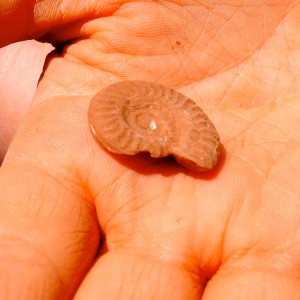Dear Naya,
One morning in April I go hunting for fossils in the mountains of Umbria with my son, who is nine and skipping with joy at this natural wunderkammer. The ancient buried seabeds have been pushed up into a high peak in the centre of Italy, from where we feel like we are on top of the world and looking down at creation. The trip is successful, and from the hillside we unearth handfuls of ammonites, mostly fragments but also a few perfectly intact spirals. We have to dig with care – these are not hard, grey stone like the ones we are used to, instead they are red and made of a compacted dry clay that is fragile and crumbles if you are too rough with them.
They recall other fossils that are not the solid dinosaur bones you think of when you hear the word fossil. They are more like the soft-bodied Hallucigenia worms found in the shale of the Canadian Rocky Mountains, shadowy imprints of animals that had melted away long before the dinosaurs arrived. Or the Palynomorphs, microfossils of pollen, layers of dust wet-sieved from the rock and preserved under liquid. There are trace fossils that are not even the animals themselves, but tracks of their movements, the rollings and burrowings of trilobites across the ocean floor over 300 million years ago.
In the three cities of Graz, Trieste and Sarajevo there are memories like these red clay ammonites – both personal memories and collective memories – that can be uncovered and deciphered only with great care, buried traces in fragments, or whole but fragile, never quite properly set. There are shadowy imprints left by the gentle people who go about their everyday lives while the world hardens around them, and there are the tracks of their movements, their daily rhythms, that are small, insignificant, private, and more beautiful for it.
